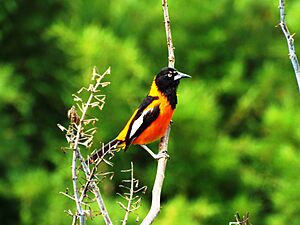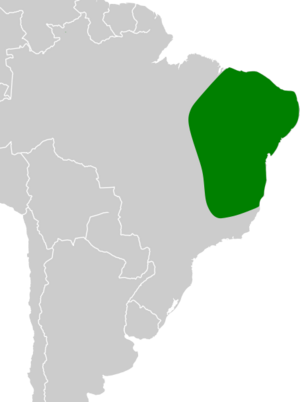Campo troupial facts for kids
Quick facts for kids Campo troupial |
|
|---|---|
 |
|
| Conservation status | |
| Scientific classification | |
 |
The campo troupial (say: TROO-pee-al), also called the campo oriole, is a colorful bird found in northeastern Brazil. It belongs to the Icteridae family, which includes orioles and blackbirds. This bird is known for its bright orange and black feathers. Even though it looks a lot like some other troupials, scientists now agree it's its own special kind of bird. It's quite common, so experts are not worried about it disappearing.
Contents
What's in a Name?
The campo troupial got its official scientific name, Icterus jamacaii, a long time ago in 1788. A German scientist named Johann Friedrich Gmelin gave it this name. He based it on descriptions from an even older book from 1648 about the natural history of Brazil.
The word Icterus comes from an old Greek word. It was the name of a bird that people believed could cure a sickness called jaundice. The second part of its name, jamacaii, comes from the local Brazilian name for the bird.
How to Spot a Campo Troupial
The campo troupial is a strong bird, about 23 cm (9 in) long, which is about the length of a ruler. It has a long tail and a wide beak. Its body is bright orange, but it has a black hood, black bib (like a small scarf), black back, black wings, and a black tail. There's a slightly uneven line where the black bib meets its orange chest.
It looks very similar to the Venezuelan troupial. However, the campo troupial has only a small white patch on its wings. It also has very little bluish skin around its eye. Another difference is that it has orange patches on its shoulders, which the Venezuelan troupial does not.
You might also confuse it with the orange-backed troupial. But the orange-backed troupial has an orange head with only a small black patch on its forehead. It also has a very clear, sharp line between its black bib and its orange chest.
Where They Live
The campo troupial lives only in northeastern Brazil. Its home area is huge, covering more than 2,000,000 square kilometres (770,000 sq mi). These birds usually live in dry scrubland and forests where trees lose their leaves. They can be found at heights up to 700 m (2,300 ft) or even higher. The areas where the campo troupial, Venezuelan troupial, and orange-backed troupial live do not overlap.
What They Eat and How They Live
Campo troupials eat a variety of foods. Their diet includes insects and other small creatures without backbones. They also enjoy fruits and the sweet liquid from flowers called nectar. One bird was even found with 126 fly larvae in its stomach!
They usually lay eggs and raise their young during the wet season, which is from December to March in Brazil.
Is the Campo Troupial Safe?
Yes, the campo troupial is a fairly common bird. It lives across a large area, and its numbers seem to be steady. Because of this, the International Union for Conservation of Nature (a group that checks on animals) says it is a "least concern" species. This means they are not worried about it becoming endangered anytime soon.


